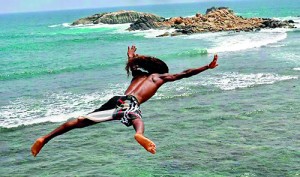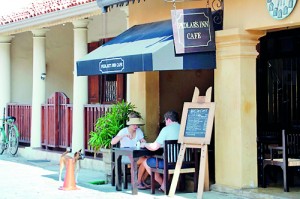Galle Fort: Soak in the old and new
It is no exaggeration to call the Galle Fort, one of the best day get-aways from Colombo. And it’s just a 45- minute drive away on the Southern highway which makes it an irresistible destination. Pack for a day, put on your walking shoes and grab a hat and of course, that camera!
![Entrance[1]](http://www.sundaytimes.lk/140504/uploads/Entrance1-300x199.jpg)
Weathered walls: The main entrance to the Galle Fort

Just passing through or spending the day only? Our new travel series gives you a quick guide to the country’s many great destinations
The beautiful capital of the Southern Province, Galle boasts of a history stretching back centuries, even before the Portuguese, Dutch and British colonial times. In the old days when Galle was a busy port, foreign traders – Greeks, Arabs, Romans and Chinese stopped by. Galle is marked in Ptolemy’s world map of 125-150 AD and the Arab traveller Ibn Batuta made it a port of call in the mid 14th century.
Galle’s Dutch Fort declared an archeological reserve by the UN since 1969 is also a UNESCO world heritage site. Enter the Fort through one of the two main entry points- the Main Gate built by the British in 1873, between the Sun and Moon Bastions, and the Old Gate on Queen Street which was completed by the Dutch in 1669.
Interestingly, construction of the Fort was started by the Portuguese who first arrived in Galle in 1505 with Lorenzo de Almeida making contact with King Dharmaparakramabahu and getting his blessings to build a camp. Built ostensibly to ensure the safety of the island, ultimately it became a prison for the local Sinhalese who rebelled against the Portuguese oppression.
After a bloody siege in 1640, the Dutch seized Galle Fort and began constructing the magnificent 36 hectare hexagonal stone fort that survives intact to this day, with its granite and coral bastions and military architecture of European design. The Dutch introduced a system of roads and canals for transportation and a sewage system that carried all the waste from inside the Fort to the sea by gravity, using the high tide.

A cliff jumper in action
The British army took over the Fort in 1796 and today, centuries later, it remains the best preserved and most intact fortified city built by the former European colonial rulers in Asia. The narrow streets of Galle Fort lined with villas and old houses with pillared verandahs and arched doorways which still bear Dutch lettering on their facades, while redolent of the past, are equally the setting for a living city with residents going about their day-to-day business and walking the old ramparts at sunset.
Galle’s mixed cultural heritage is plain to see- the sound of church bells mingles with the call to prayer from the mosques and the Pali chants from Buddhist temples heard every evening.
Stroll through the quaintly named streets- Pedlar Street, Church Street and you will see the Old Dutch and English churches. Pause to explore the old Dutch Reformed Church (Groote Kerk) with its gabled roofs which was built in 1640 though the present structuredates from 1752 to 1755. This has the tombs of Dutch officials within and carved memorial tablets on the walls which hint at intriguing stories of lives lost.
![Maritime Museum[1]](http://www.sundaytimes.lk/140504/uploads/Maritime-Museum1-300x199.jpg)
The Maritime Museum.
The massive VOC (the Dutch East India Company) warehouses, the Court Square, the elegant pillared facade of the Old Dutch hospital, the Shri Sudarmalaya Buddhist temple and the Clock Tower are all other sites worth exploring. Make sure to take a walk down Leyn Baan Street to reach the ramparts. The Meeran Jumma Mosque re-built in 1904 is a landmark not to be missed. The original mosque is said to have stood from the 1750s.
Arriving at the ramparts stop by the lighthouse, to take in the view. This is an offshore Lighthouse operated and maintained by the Sri Lanka Ports Authority and incidentally the country’s oldest light station dating back to 1848 though the original lighthouse was destroyed by fire in 1934.
The Dutch Warehouse and National Maritime Museum and Information Centre is another ‘must-see’ not just for maritime buffs for its

the street cafes now very much a part of Galle Fort
collection of marine biological and anthropological material but also because of its innovative and modern display and effective use of an original historic space- the warehouse was built in 1671. The first gallery depicts the types of watercraft used in passenger transport and maritime trading in southern Sri Lanka.
The second gallery is focused on marine eco systems and their flora and fauna. Models of mangroves, sea shore plants, turtles, sea birds and marine mammals are displayed with their taxonomic details. Don’t miss the large skeleton of a Whale mounted on the roof. The Museum is closed on national holidays, Sundays and Mondays but open from 9 – 5 on other days. A nominal entry fee is charged.
The Galle National Museum in the oldest Dutch building of the Galle Fort, constructed in 1656 has a collection of traditional masks used in various rituals, ornamental objects made up of turtle shell, ancient wooden carvings and a Beeralu collection. There are large water vessels, V.O.C. porcelain and arms and weapons used by the Dutch soldiers, all obtained from Dutch ships of yore. Opening hours are like the Maritime Museum.
Another landmark in the Fort is the magnificent colonial mansion built in 1684 to house the Dutch Governor and his staff and converted into the New Oriental Hotel in 1856. It is now the luxurious ‘Amangalla’ Hotel.
At sunset, stop by the ramparts to see the ‘jumpers’ in action. These young men who make the daring and dangerous leap off the ramparts into the churning waters below are an integral part of the Fort experience.
There’s no doubt, Galle Fort has a trendy vibe thanks to the advent of boutiques, hotels and restaurants, coffee shops, designer clothing shops and galleries. Home to the Galle Literary Festival which brought international writers and literary minded visitors, the Fort has become a popular location for television commercials, photo-shoots and even movies. The sizeable population of foreign artists and writers has seen cafes and coffee shops mushrooming to cater to the demand, so there are places aplenty for lunch, tea or coffee to suit your budget.


